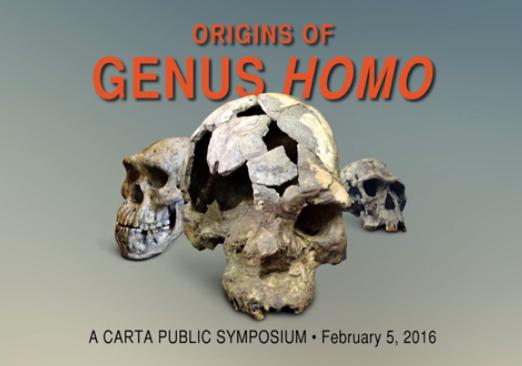Origins of Genus Homo
Despite discoveries of remarkable new fossils in recent years, the evolutionary events surrounding the origins of genus Homo are incompletely understood. This CARTA symposium explores evidence bearing on the emergence of our genus, focusing on possible antecedents to Homo, changes in diet and body form as Australopithecus evolved toward Homo, ancient species within the genus, and evolutionary processes likely operating 2.5 - 1.5 million years ago. (from carta.anthropogeny.org)
 |
1. Homo - What, Who, When, Where?
In this talk, Bernard Wood explains what he looks for within the fossil record when searching for the origins of our own genus, Homo.
2. Australopithecus and the Emergence of Earliest Homo
The age of origin of the Homo lineage is thought to have fallen between 2.5 and 3.0 mya. However, William Kimbel argues in this talk that recent fossil and stone tool discoveries call for a new evaluation of factors involved in the origin and the early evolution of Homo.
3. Dmanisi, Variation, and Systematics of Early Homo
Philip Rightmire describes the rich array of early hominin fossils discovered at the Dmanisi site in the Georgian Caucasus.
4. Adaptive Shifts Accompanying the Origin of Homo
Daniel Lieberman argues that genus Homo differs from other early hominins through an integrated suite of behaviors, collectively termed hunting and gathering, that emerged sometime between 3 and 2 mya.
5. A Potential Molecular Mechanism for the Speciation of Genus Homo
The human species underwent a watershed change in the biochemical composition of its cell surfaces, via a genetic event estimated to have occurred ~2-3 mya, which is also the apparent period of the emergence of the genus Homo.
6. Southern Africa and the Origin of Homo
In the last seven years, two hominin species possessing a mixture of primitive and Homo-like morphology Australopithecus sediba and Homo naledi have been discovered in South Africa.
7. Evolution of Early Human Body Form
New fossil evidence of hominin diversity suggests that there was not a single transition to human-like body form in early Homo. In this talk, Carol Ward explains how this may be changing our ideas about the origins of our genus.
8. Evolution of Human Life History Patterns
Leslie Aiello explains that although the fossil record offers clues that cooperative childcare may have been present early in the evolution of genus Homo, the full human life history pattern were much more recent evolutionary developments.
9. Energetics and the Ecology of Early Homo
In this talk, Herman Pontzer investigates humans' evolving metabolic strategy and its origins in the fossil record.
| Related Links |
| Walking with Cavemen This is a four-part BBC documentary series narrated by Robert Winston, about the story of human evolution from Australopithecus afarensis to Homo sapiens. |
| Prehistoric Autopsy This is a BBC documentary series presented by Professor Alice Roberts and Dr. George McGavin, taking us on an evolutionary journey to meet three of our ancient ancestors - Neanderthals, Homo Erectus, and Lucy. |
| Origins of Us This is a BBC documentary series presented by Dr. Alice Roberts, showing how we evolved away from our ape cousins to become the adaptable, successful species we are today. |
| The Evolution of Human Biodiversity This is a series of videos on the evolution of human biodiversity from CARTA (Center for Academic Research & Training in Anthropogeny). |
| The Upright Ape: Bipedalism and Human Origins Why are we the only two-legged creature to develop an exclusively upright gait? And what did it mean to the development of the human species? |
| Behaviorally Modern Humans: The Origin of Us One of the enduring questions of human origins is when, where and how we Behaviorally Modern Humans emerged and why and how we eventually replaced all the other human-like species. |
| Becoming Human: Unearthing Our Earliest Ancestors This is a three-part NOVA's documentary series investigating the recent discoveries transforming our understanding of our human origins. |
| Ancient DNA and Human Evolution This symposium brings together researchers at the forefront of ancient DNA research and population genetics to discuss current developments and share insights about human migration and adaptation. |
| Unique Features of Human Skin The skin is the major interface between the human body and its environment. It supports diverse and complex functions from protection to vitamin photosynthesis, thermoregulation, and communication. |